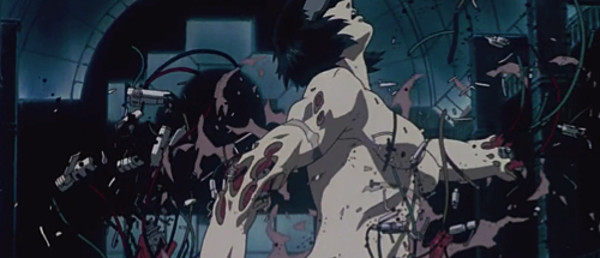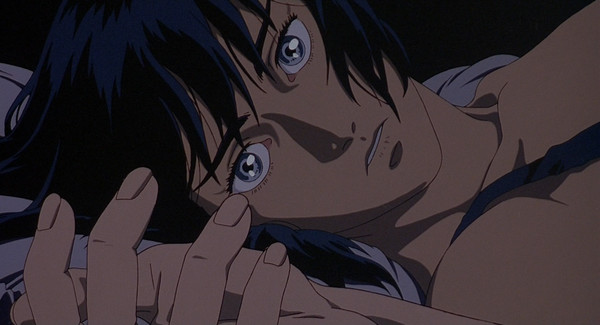Determining the Best Ghost in the Shell
by J. A. Micheline,Firstly: I'm not here to argue whether Ghost in the Shell is the one of the best anime of all time. We already know it is. That first film? It was the best. The TV series? Also the best. And this new film - the one that was released in Japan on Saturday, not the Hollywood one with Scarlett Johansson and other assortedwhite people - is also going to be the best. But with all these versions - and you and you can vote for your personal best here, I had to wonder -- of all these bests, which is the best?

Ghost in the Shell Arise / Alternative Architecture (2013-15)
Coming in at #5 is the most recent iteration--which is already a bit complicated. First, Production I.G released ARISE as a four-part OVA that is part prequel, part its own thing. It shows us how Section 9 began, but also presents histories that are different from those in either the films or Stand Alone Complex. Then, after the film was announced, Production I.G aired the four ARISE episodes in two parts each, added a brand new two-part episode that bridges to the film—and called the whole thing ARISE / Alternative Architecture.
There are parts of Arise that I love, but it's not the one I would start with if I were trying to get a friend into the franchise. The animation is absolutely gorgeous, which makes the fight scenes fluid and engaging, but the character design is a step down from the other versions. The Major is full cyborg, so she can, of course, look however she wants, but the decision to put her in a more child-like body is definitely an interesting one. Otherwise, none of Section 9's designs are updated from their older versions, which is kind of a shame considering how much real-world time has passed between this version and the last. Even the Logicomas aren't quite as fun as their predecessors.

Still, there are a couple of episodes in there that I genuinely love for their complexity and storytelling. We get the classic nods to some Ghost in the Shell staples, but also some new territory. You'll almost certainly have to watch the first episode, “Ghost Pain,” twice to really understand exactly what's going on – lots of intrigue related to false memories and reality. Meanwhile, “Ghost Tears” offers scenes and situations in which we haven't seen The Major before, as well as unlocking a new part of her backstory. But as an overall work, you can't really say that it's as smart, tightly crafted, or emotionally charged, as the versions that came before. Of course, that's not to say that the film doesn't or won't be able to pull off something great with a story of its own. Remember: all versions of Ghost in the Shell are the best—it's just that AAA isn't #1.
But don't worry. We'll get there.

Ghost in the Shell 2: Innocence (2004)
Ranked number four is the 2004 sequel to the original film. In terms of its CV alone, Innocence is a pretty impressive film. It was the sixth animated film to ever be screened at the Cannes Film Festival.
From the outset, it's great to have a story that focuses on Batou and Togusa. We get to see how they've been doing and what they've been up to and it's nice to be back with old friends on a new mission. The story follows the two of them on a new case that brings to light questions about ghost dubbing—and reality—expanding the GitS universe a little bit more. The case itself is solid, relatively interesting, and well-constructed, but the philosophical themes that we've grown to love from the franchise are a bit too heavy-handed. Innocence tries too hard to be as smart as its predecessor and ends up showing its hand more than it should.

Nonetheless, the animation is stunning and we come to understand more about Batou, in particular, than we were granted in the first film. There's more to him than meets the cybernetic eye and the events of Innocence are very much dependent upon his emotional state and narrative. Getting a deeper look into his character is probably the most rewarding thing about this sequel. And, of course, we get to see The Major again too. And, as a bonus for those of you who get a little bit heartbroken every time The Major leaves (*ahem*), Innocence offers closure for you and Batou both.

Ghost in the Shell: Solid State Society (2006)
Solid State Society is the made-for-TV film that serves as a sequel to the Stand Alone Complex TV series. It takes third place because it does almost everything that Innocence wants to do, but better.
Once again, we have a Togusa-Batou focused narrative--though this one leans more on Togusa, while Innocence leaned more on Batou--this time less overtly philosophical. Instead, it takes a more measured and subtle approach, which is what the best versions of Ghost in the Shell are known for.
Just like in Innocence, the SSS case is interesting, expands the universe, and builds upon a number of emotional themes that were present in the TV series. We get echoes of the Stand Alone Complex idea through the Solid State Society's rhizome – a copy/creation without an original. Meanwhile, Togusa's concern for family becomes a fairly prominent element of the story. It's stronger than Innocence, but still not as phenomenally interesting or thought-provoking as the versions that outrank it. Still, the animation is great—yes, I'm going to say that for every single one of them because yes, the animation is great—and we see Togusa move out of his rookie role to become the leader of Section 9. Which is just delightful.

What also makes Solid State Society top 3 worthy is Yōko Kanno's soundtrack. Yes, that's right, the anime OST goddess herself gifted this film with her glory. There is some absolute beauty in this soundtrack—personal favorites are “Take a Little Hand” and “Zero Signal.” Kanno's work on the Stand Alone Complex IP sets the perfect tone and makes every scene that much more moving or exciting. The album is a beautiful meld of haunting vocals, electronica, strong guitar riffs. It's a musical description of what I envision the Ghost in the Shell world looking like.

Ghost in the Shell (1995)
Number two, in fact, the original film. Mamoru Oshii’s seminal adaptation of Masamune Shirow's manga is, by and large, the reason we are here some 20 years later. Hell, it's the reason a lot of other cyberpunk film is here too. The Wachowskis specifically citedGhost in the Shell as an influence for creating The Matrix and even now there are scientists trying to recreate its thermo-optic camouflage.
There is so much to love here – the animation is brilliant. It may not be slick or smooth like the modern AAA but that aspect in itself somehow characterizes the (paradoxically) retro nature of cyberpunk. Everything is kind of halted in the 80s and 90s, so 90s-style animation suits the thematic content completely. Still, even with its lack of modernity, it is utterly gorgeous. The degree of detail and attention given to characters’ eyes—particularly The Major's—is almost intoxicating. There's a depth of expression that none of the other works manage to hit. And yet, at the same time, you constantly feel like she's looking through you.

And then, of course, there's the opening scene featuring the construction of The Major's cyber body, which is nothing short of iconic. Artists are still trying to recreate it almost twenty years later. So much work is being done in terms of the building of a body, the building of a ghost, the building of a female body, the viewing of it as an object – and that's all before we even get to the plot. It's such a masterful thematic exploration that sets the tone and pace for the rest of the film.
We can't neglect the music here either. Composed by Kenji Kawai, the main theme mixes Bulgarian harmonies with traditional Japanese tones, using an ancient version of the Japanese language. This mixing and melding that ultimately leads to a wedding song is reflective both of the climax of the film, when The Major and The Puppetmaster become one, but also the lack of clear borders—between humans and machines, between genders, between the self and the other—that emerges in a cybernetic world. Incredible.

Last, but not least, there's the story. This is where all of these spring-loaded themes explode. Within a single case, the film manages to juxtapose thought-provoking questions about the philosophy of identity with action scenes that are both fantastic and visceral. My biggest problem with it is that there isn't more of everything. I want more than two hours. I want more twists and turns in the case. I want a more extensive mystery.
And that's where our number one comes in.

Ghost in the Shell: Stand Alone Complex and 2nd G.I.G. (2002-2005)
Ghost in the Shell: SAC is everything that's amazing about the other versions, except with more time given to fully developing our main cast of characters and build a phenomenal story.
In season one (1st G.I.G.), the Complex episodes weave together a brilliant mystery involving The Laughing Man that raises as many questions as it answers. It's so cleverly put together, with clues and plot developments placed precisely where they need to be, even in the background of other cases. We unravel a conspiracy, we learn who the Laughing Man is, we learn who the Laughing Man is not, and even at the end of the season, we get the sense that we may never know everything, that some answers are just outside our reach. And yet, the Stand Alone episodes, the ones that are unrelated to the main plot, are still just as tightly crafted and rich in emotional and world-building content. And, of course, all of this repeats in 2nd G.I.G.’s Dividual and Individual episodes.
We simply have more time to get to know The Major, Batou, Togusa, Aramaki, and my god, even the Tachikoma get their own, incredible narrative arc. The show knows that its advantage is time, and both character and story are wrung out of every single second. Many, if not most, of these 20-minute episodes have the same impact as the 2-hour 1995 film.

What's more, Yōko Kanno is once again responsible for the music, which is an enormous bonus. Though there are some lyrical tracks in the SSS OST, there's much more on three SAC albums (plus the special one all about Tachikoma), which adds a lot. One track, “Beauty is Within Us” very directly approaches gender dysphoria – and is tied with an episode about a man who cannot accept his failing human body and instead replaces it with an enormous steel tank. The season 1 opening track, Inner Universe, is game-changing and, really, the rest of the music is much the same. There are songs in Russian, English, Latin, and much more—and they are as beautiful as they are frightening, empowering, and engaging.
Of course, the animation still absolutely kills.
With beautiful music, unforgettable storylines, and a cast of amazing characters, how could Stand Alone Complex be anything but the best?
What's your favorite version of Ghost in the Shell? Have you seen everything the franchise has to offer? Let us know in the comments and vote in the poll!
discuss this in the forum (62 posts) |
this article has been modified since it was originally posted; see change history